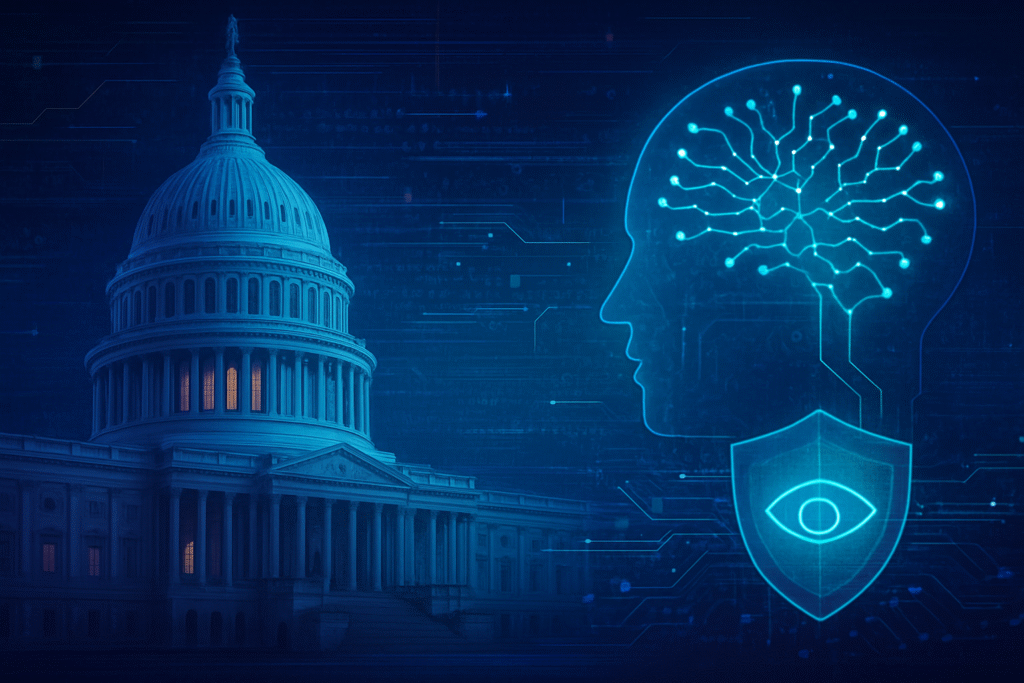
In a significant legislative move that underscores the growing concern over the weaponization of artificial intelligence, the U.S. House of Representatives has unanimously passed the Generative AI Terrorism Risk Assessment Act (H.R.1736). The bill, which cleared the House by voice vote on November 19, 2025, mandates the Department of Homeland Security (DHS) to conduct annual assessments of the terrorism threats posed by malicious actors exploiting generative AI. This bipartisan action signals a proactive stance by the U.S. government to understand and mitigate the national security risks inherent in rapidly advancing AI technologies.
The immediate significance of this legislation is profound. It establishes a dedicated mechanism for the U.S. government to monitor how terrorist organizations, such as ISIS and al Qaeda, might leverage generative AI for nefarious activities, moving from a reactive to a proactive defense posture. By requiring enhanced inter-agency collaboration and information sharing, the Act aims to foster a holistic understanding of AI-related national security threats, improving intelligence analysis and response capabilities across all levels of government. Its unanimous passage also highlights a strong bipartisan consensus on the serious implications of AI misuse, setting a precedent for future legislative actions and framing a critical national dialogue around the responsible development and deployment of AI with security considerations at its core.
Unpacking the Generative AI Terrorism Risk Assessment Act: Technical Scope and Mandates
The Generative AI Terrorism Risk Assessment Act (H.R.1736) is a targeted piece of legislation designed to address the emergent capabilities of generative AI within the national security context. At its core, the bill defines "generative AI" as a class of artificial intelligence models capable of emulating the structure and characteristics of existing input data to produce new, synthetic content, including images, videos, audio, text, and other digital material. This precise definition underscores the legislative focus on AI's ability to create realistic, fabricated media—a capability that poses unique challenges for national security.
The Act places several key responsibilities on the Department of Homeland Security (DHS). Foremost, DHS is mandated to provide Congress with an annual assessment of the threats to the United States stemming from the use of generative AI for terrorism. This reporting requirement is slated to conclude six years after the bill's enactment. To execute these assessments effectively, DHS must consult with the Director of National Intelligence and is empowered to receive relevant information from other federal agencies, including the Office of the Director of National Intelligence, the Federal Bureau of Investigation (FBI), and other intelligence community members. Furthermore, DHS is tasked with reviewing and disseminating information collected by the national network of fusion centers, which are crucial collaborative entities at state and local levels for intelligence sharing.
This legislative approach marks a significant departure from previous methods of addressing technological threats. While past efforts might have broadly addressed cyber threats or propaganda, H.R.1736's specificity to "generative AI" acknowledges the distinct challenges posed by AI's content-creation abilities. The rationale for this legislation stems from observations that terrorist organizations are already "weaponizing" generative AI to automate and amplify propaganda, create false realities, and spread misinformation, making it increasingly difficult to discern factual content. By requiring annual assessments and enhancing information sharing specifically related to AI-driven threats, the legislation aims to close critical gaps in national security. While initial reactions from the broader AI research community and industry experts specifically on H.R.1736 are not extensively detailed in public records, the general consensus within the national security community supports proactive measures against AI misuse.
Shifting Sands: The Act's Impact on AI Companies and the Tech Landscape
While the Generative AI Terrorism Risk Assessment Act primarily mandates governmental assessments and information sharing, its implications for AI companies, tech giants, and startups are significant and multifaceted. The legislation serves as a clear signal to the industry, influencing competitive dynamics, product development, market strategies, and creating new demand for security solutions.
Companies specializing in AI security, threat detection, and content moderation are particularly well-positioned to benefit. As DHS focuses on understanding and mitigating AI-driven terrorism threats, there will be an increased demand for tools capable of detecting AI-generated propaganda and misinformation, monitoring online platforms for radicalization, and developing robust safety and ethics frameworks. This could lead to a burgeoning market for "red-teaming" services—experts who test AI models for vulnerabilities—and create new opportunities for both established cybersecurity firms expanding into AI and specialized AI startups focused on safety and security.
Major AI labs, often at the forefront of developing powerful generative AI models, will face heightened scrutiny. Companies like Alphabet (NASDAQ: GOOGL), OpenAI, and Meta Platforms (NASDAQ: META) may need to allocate more resources to developing advanced safety features, content filters, and explainable AI capabilities to prevent their models from being exploited. While H.R.1736 does not directly impose regulatory burdens on companies, the DHS assessments are likely to inform future regulations. Larger companies with greater resources may be better equipped to handle potential future compliance costs, such as rigorous testing, auditing, and reporting requirements, potentially widening the competitive gap. Moreover, labs whose models are found to be easily exploited for harmful purposes could face significant reputational damage, impacting user trust and adoption rates.
The primary disruption to existing products and services would stem from increased awareness and potential future regulations spurred by the DHS assessments. Generative AI platforms may need to implement more stringent content moderation policies and technologies. Companies might revise terms of service and implement technical limitations to prevent the use of their AI for activities identified as high-risk. While not explicitly stated, heightened concerns about misuse could lead some developers to reconsider fully open-sourcing highly capable generative AI models if the risks of weaponization are deemed too high. Consequently, AI companies will likely adapt their market positioning to emphasize trust, safety, and responsible innovation, with "secure AI" becoming a key differentiator. Collaboration with government and security agencies, along with increased transparency and accountability, will be crucial for market positioning and influencing future policy.
A New Frontier: Wider Significance in the AI Landscape
The Generative AI Terrorism Risk Assessment Act (H.R.1736) marks a critical juncture in the broader artificial intelligence landscape, underscoring the urgent need for governments to understand and counter the malicious exploitation of AI. Its significance lies in its direct response to the "dual-edged sword" nature of generative AI, which offers transformative opportunities while simultaneously presenting substantial national security risks. The Act acknowledges that while generative AI has numerous positive applications, it can also be "dangerously weaponized in the wrong hands," particularly by terrorist organizations already experimenting with these tools for propaganda, radicalization, and even operational enhancement.
The Act's impact on AI development, while indirect, is profound. It signals an elevated level of governmental scrutiny on generative AI technologies, particularly concerning their potential for misuse. This could prompt AI developers to incorporate more robust safety and security measures into their models, potentially through "red-teaming" or ethical AI practices, to mitigate terrorism-related risks. The annual assessments mandated by DHS could also inform future guidelines or voluntary standards for AI development, steering innovation towards "responsible AI" that prioritizes security and ethical considerations. Should these assessments reveal escalating and unmitigated threats, H.R.1736 could serve as a precursor to more direct regulatory frameworks on AI development, potentially leading to restrictions on certain capabilities or mandatory safeguards.
This legislative action epitomizes the ongoing tension between fostering technological innovation and ensuring national security. A primary concern is that a strong focus on security, especially through potential future regulations, could stifle innovation, discouraging investment and limiting groundbreaking discoveries. Conversely, under-regulation risks exposing society to significant harm, as AI's rapid advancement can quickly outpace existing rules. H.R.1736 attempts to navigate this by focusing on intelligence gathering and assessment, providing a continuous feedback loop to monitor and understand the evolving threat landscape without immediately imposing broad restrictions.
Compared to previous AI milestones and regulatory attempts, H.1736 is a targeted legislative reinforcement. President Biden's executive order on AI in 2023 was a landmark, establishing the U.S.'s first comprehensive regulations on AI systems, including rigorous testing to prevent misuse in biological or nuclear weapons. The European Union's AI Act, which entered into force in August 2024, takes a broader, risk-based approach to regulate AI across all sectors. H.R.1736, while less sweeping than the EU AI Act, is a more specific response to the observed and anticipated misuse of generative AI capabilities by terrorist groups, solidifying the national security aspects outlined in the executive order. It echoes past legislative efforts to address emerging technologies exploited by terrorists, but AI's rapid evolution and broad applicability introduce complexities not seen with previous technologies, making this Act a significant step in acknowledging and addressing these unique challenges.
The Road Ahead: Future Developments in AI and National Security
The passage of the Generative AI Terrorism Risk Assessment Act (H.R.1736) by the House of Representatives is poised to catalyze several near-term and long-term developments in the realm of AI regulation and national security. In the immediate future, we can expect increased scrutiny and reporting as DHS initiates its mandated annual threat assessments, leading to more structured information gathering and enhanced interagency coordination across federal agencies and fusion centers. This will solidify AI-enabled terrorism as a national security priority, likely spurring further legislative proposals and executive actions. There will also likely be increased engagement between government agencies and AI developers to understand model capabilities and vulnerabilities, potentially leading to industry best practices or voluntary guidelines.
Looking further ahead, the annual threat assessments will provide invaluable data, informing the development of more comprehensive and precise AI regulations beyond just reporting requirements. These could include specific guidelines on AI model development, data governance, and ethical use in national security contexts. A sustained focus on generative AI threats will also spur the development of advanced technological countermeasures, such as sophisticated deepfake detection tools, automated content moderation systems, and advanced anomaly detection in digital environments. Addressing AI-enabled terrorism effectively will necessitate greater international cooperation to share intelligence, develop common standards, and coordinate responses to global threats. Furthermore, the increasing reliance on AI will necessitate a significant shift in the national security workforce, requiring more personnel skilled in data science, AI ethics, and human-AI teaming.
The bill's mandates highlight a dual pathway for AI's future: its potential for both beneficial applications in national security and its misuse by malicious actors. On the beneficial side, AI can revolutionize intelligence analysis and threat detection by processing vast datasets to identify patterns and predict radicalization pathways. It can fortify cybersecurity, enhance autonomous defense systems, improve border security through facial recognition and biometric analysis, and optimize resource management. Conversely, in counter-terrorism efforts specifically addressing generative AI threats, we can expect accelerated development of AI models for deepfake detection and authentication, automated content moderation to remove terrorist propaganda, identification of red flags in radicalization, and disruption of financial networks supporting terrorist organizations.
However, the implementation of H.R.1736 and broader AI regulations in national security presents significant challenges. Balancing national security with civil liberties and privacy remains a critical concern, especially given the "black box" problem of many AI systems and the risk of algorithmic bias. The rapid evolution of AI technology means that regulations could quickly become outdated, or new AI capabilities could emerge that circumvent existing safeguards. Adversarial AI, where terrorist groups leverage AI to enhance their own capabilities, necessitates a continuous arms race in AI development. Furthermore, challenges related to data integrity, interagency collaboration, workforce expertise, and establishing robust ethical frameworks for AI in counter-terrorism will need to be addressed. Experts predict that national security will continue to be a primary driver for AI regulation in the U.S., with a continued emphasis on responsible AI, AI model reporting and controls, and a critical balance between fostering innovation and protecting national interests.
A Defining Moment: Comprehensive Wrap-up and Future Outlook
The unanimous passage of the Generative AI Terrorism Risk Assessment Act (H.R.1736) by the House of Representatives on November 19, 2025, marks a defining moment in the legislative response to the rapidly evolving landscape of artificial intelligence. The bill's core mandate for the Department of Homeland Security to conduct annual assessments of generative AI-driven terrorism threats underscores a proactive recognition by the U.S. government of AI's potential for misuse by malicious actors. Key takeaways include the explicit definition of generative AI in a national security context, the acknowledgment of how terrorist groups are already exploiting these tools for propaganda and radicalization, and the emphasis on enhanced inter-agency information sharing to close critical security gaps.
This legislation holds significant historical weight in the context of AI. It is one of the pioneering pieces of legislation specifically targeting the national security risks of generative AI, moving beyond general discussions of AI ethics to concrete demands for threat evaluation. This act sets a precedent for how governments might approach the security implications of future advanced AI systems, demonstrating an early legislative attempt to grapple with the "weaponization" of AI by non-state actors. Its unanimous support in the House signals a bipartisan consensus on the urgency of understanding and mitigating these emerging threats, paving the way for a more formalized approach to AI governance in national security.
The long-term impact of H.R.1736 is likely to be multifaceted. It is expected to lead to enhanced threat intelligence, informing future policy development and potentially more comprehensive regulations. The bill implicitly pressures AI developers to incorporate "safety by design" principles into their models, fostering a sense of industry responsibility. Furthermore, this Act could serve as a blueprint for how legislative bodies address risks associated with other rapidly advancing, dual-use technologies. A critical long-term challenge will be to continuously balance national security imperatives with ethical considerations such as freedom of speech and privacy, especially as AI-generated content increasingly blurs the lines between factual and synthetic information. The ultimate effectiveness of the bill will hinge on the rigor of DHS's assessments and the subsequent legislative and executive actions taken based on those findings.
In the coming weeks and months, all eyes will turn to the U.S. Senate, where H.R.1736 will now move for consideration. Watch for its introduction, referral to relevant committees, and any scheduled hearings or markups. The speed of its passage in the Senate will indicate the level of bipartisan consensus on this issue at the upper chamber. Potential amendments could alter its scope or requirements. If the bill passes the Senate and is signed into law, attention will then shift to DHS and its preparations for conducting these annual assessments, including budget allocations, staffing, and methodology development. The release of the first assessment reports, due within one year of enactment, will offer initial insights into the U.S. government's understanding of this evolving threat, shaping further policy discussions and potentially spurring increased international cooperation on AI regulation and counter-terrorism efforts.
This content is intended for informational purposes only and represents analysis of current AI developments.
TokenRing AI delivers enterprise-grade solutions for multi-agent AI workflow orchestration, AI-powered development tools, and seamless remote collaboration platforms.
For more information, visit https://www.tokenring.ai/.





